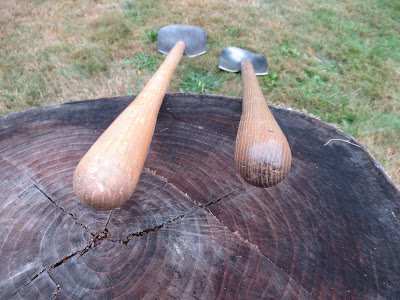The idea behind the winter cover crop is to keep the soil from being exposed to the elements during winter. Eaton Rapids Joe says it better: “One reason to plan a cover crop over the winter is so your nutrients don't leach downward out of the root zone.” It is also great for building up the humus – organic matter in the soil. Constant nitrogen inputs, organic feed meals, hotter manures, or otherwise, will deplete your humus content as the microbes consume it when breaking down the fertilizers.
I found that out the hard way when I used to move / rotate my chicken run into each bed during the winter. I wasn’t adding organic matter to the hot manure, even though it was scratched in by the birds and naturally sheet composted in the soil. Gradually my soil got gummier and stickier as humus and tilth degraded.
One way to improve my humus content was to plant a fibrous rooted plant like Rye in the fall. Both Eliot Coleman and Steve Solomon lean towards other cover crops and ‘green manures’ preferring legumes like vetches, clovers, field peas and the like. They prefer ones that are killed with the frost and so don’t produce weed seeds and are easy to till in in the spring. Both deem rye as too hard to work with in the spring (it can grow quickly) --- better for agribusiness and its machinery they say.
But I’ve had good success with Fall Rye. It gets planted in most beds after their crop has been harvested. The secret is to cover it with black plastic in the spring, a month or more before needing to work the bed. This covering stunts or even kills the rye plants and still leaves a good supply of fine rootlets in the soil.
The plastic cover also keeps the soil dryer during our very wet Pacific North West spring so I can pull off the plastic, trim the edges for weeds and till. No need to wait for 3 or more dry days before working the soil.
My son TOG likes to stir in all the residual organic matter but I still like to shake out by hand the remaining plants in the spring so they don’t foul my little tiller. This still leaves a lot of mostly decomposed organic matter in the soil. My tilth has been improving these last 5 years without chickens. But now with two new birds acquired for this Covid emergency, I’ll be more considerate in adding additional organic matter into their run as well as the fall rye they get to eat and dig up.
Several years ago, I bought a big sack of rye seed from Otter Co-op to last a number of years. Alas, the second year it grew bugs instead. I left the grain in its original sack in the garage and the moths and their worms went for it. Smart bugs, they ate the germs – the nutritious plant growing part -- and left the rest of the seed grain. I tried planting that the third year but nothing came up.
So I bought another sack – it’s so much cheaper per pound than buying smaller quantities. This time I stored it in a large plastic pail with a tight lid but also added a secret weapon: cinnamon sticks. And boy did that work.
No moths or worms or clumpy webs in the rye seed. This year my two year old seed came up splendidly. (cinnamon sticks also work great for keeping the bugs out of larger stored quantities of walnuts, oatmeal, organic whole grain flours and the like.)
I experimented with seeding 1 lb per 50 square feet verses ¾ lb. Also tried the usual raking the seed in verses lightly covering it with screened soil. Not too much difference so it is now to be ¾ lb per 50 square feet, raked in. (I may try ½ lb in another later bed)
First, I raked the beds flat and kept the surface stone free so I may mow it with my lawn mower if need be. Next, I broadcast seeded each bed, always sprinkling seed sparingly at first so I didn’t run out of seed prematurely and then went back and filled in any sparse spots. Then I gently raked / scuffled the bed with the teeth of my bow rake. Finally, I covered each bed with my fencing wire pieces so the neighbourhood cats wouldn’t scratch it all up.
The rye came up like weeds in the good weather. It is now tall enough for me to cut some each day for the chickens – they love it. Great for making bright yellow-orange yolks too. Now I need to remove the wire fence sections and hang them up on the back board fence for storage.
A lot of the rye won’t be needing much turning in with the birds rotating through most of the rye beds before spring. Once they’re moved out of a pair of beds, I’ll either reseed or cover with a piece of black plastic.
Soon I’ll start to rake leaves in my neighbourhood and I’ll chop up some with the lawnmower to add to the bird’s run. That should blend well with their droppings, adding some gentle carbon to help build up the humus levels.
Happy Gardening.





